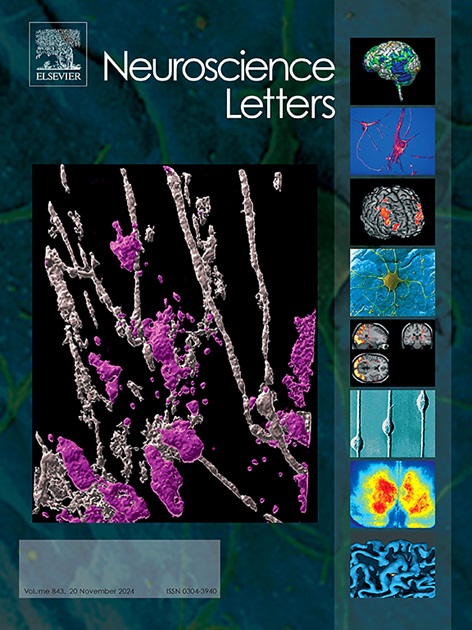Playback of ultrasonic vocalisations (38–48 kHz) communicates the state of stress and impaired context episodic memory in adolescent rats
IF 2
4区 医学
Q3 NEUROSCIENCES
引用次数: 0
Abstract
Background and aim
Maternal isolation induces ultrasonic vocalisations (USVs), and playback of these USVs can elicit response calls in receivers. In this study, we investigated whether playback of USVs (38–48 kHz) transmits a state of stress and impairs memory in receivers.
Method
Rat pups were exposed to playback of USVs or modified USVs on postnatal day (PND) 12, and their response calls were recorded. On PND-34, control (Ctrl), maternally separated (MS), USV playback (PB), and modified USV playback (MPB) groups were tested for context-dependent episodic memory. Additionally, molecular markers involved in synaptic plasticity were assessed.
Results
Playback receivers emitted specific response calls: female pups responded with step-up frequencies (39.0–49.7 kHz) to playback of USVs and with downward trills (32–39 kHz) to modified USVs. Rats in the MS and PB groups made more incorrect choices in odour-associated context transitions and long-term memory assessments than those in the Ctrl and MPB groups. Furthermore, corticosterone (CORT) levels were elevated, whereas phosphorylation of extracellular signal-regulated kinase (ERK1/2), N-methyl-D-aspartate (NMDA) receptor subunits (NR2A,2B), α-amino-3-hydroxy-5-methyl-4-isoxazolepropionic acid (AMPA) receptor subunits (GLUR1, GLUR2), postsynaptic density protein 95 (PSD-95), and mature brain-derived neurotrophic factor (mBDNF) were reduced in the MS and PB groups.
Conclusion
USV playback can transmit stress to receivers, alter molecular signalling pathways (pERK1/2, NR2A, NR2B, pGluR1, pGluR2, pPSD95, and BDNF), and impair episodic memory. This model may help identify the neuropathology of early-life stress and the development of behavioural disorders later in life.
超声波发声回放(38 - 48khz)可以传达青春期大鼠的应激状态和情境情景记忆受损
背景和目的母源隔离诱导超声发声(usv),这些usv的回放可以引起接收器的响应呼叫。在这项研究中,我们调查了usv (38-48 kHz)的播放是否传递了一种应激状态并损害了接受者的记忆。方法在出生后第12天(PND)给幼鼠播放usv或改良usv,并记录它们的应答叫声。在PND-34上,对照组(Ctrl)、母分离组(MS)、USV回放组(PB)和改良USV回放组(MPB)进行情景依赖情景记忆测试。此外,我们还评估了参与突触可塑性的分子标记。结果回放接收器发出特定的响应叫声:母鼠对usv的回放以上升频率(39.0 ~ 49.7 kHz)响应,对修改后的usv以下降颤音(32 ~ 39 kHz)响应。在气味相关情境转换和长期记忆评估中,MS组和PB组大鼠比Ctrl组和MPB组大鼠做出了更多的错误选择。此外,皮质酮(CORT)水平升高,而细胞外信号调节激酶(ERK1/2)、n-甲基-d -天冬氨酸(NMDA)受体亚基(NR2A,2B)、α-氨基-3-羟基-5-甲基-4-异氧唑丙酸(AMPA)受体亚基(GLUR1, GLUR2)、突触后密度蛋白95 (PSD-95)和成熟脑源性神经营养因子(mBDNF)的磷酸化水平在MS和PB组均降低。结论usv回放可将应激传递给受体,改变分子信号通路(pERK1/2、NR2A、NR2B、pGluR1、pGluR2、pPSD95和BDNF),损害情景记忆。这个模型可能有助于识别早期生活压力的神经病理学和以后生活中行为障碍的发展。
本文章由计算机程序翻译,如有差异,请以英文原文为准。
求助全文
约1分钟内获得全文
求助全文
来源期刊

Neuroscience Letters
医学-神经科学
CiteScore
5.20
自引率
0.00%
发文量
408
审稿时长
50 days
期刊介绍:
Neuroscience Letters is devoted to the rapid publication of short, high-quality papers of interest to the broad community of neuroscientists. Only papers which will make a significant addition to the literature in the field will be published. Papers in all areas of neuroscience - molecular, cellular, developmental, systems, behavioral and cognitive, as well as computational - will be considered for publication. Submission of laboratory investigations that shed light on disease mechanisms is encouraged. Special Issues, edited by Guest Editors to cover new and rapidly-moving areas, will include invited mini-reviews. Occasional mini-reviews in especially timely areas will be considered for publication, without invitation, outside of Special Issues; these un-solicited mini-reviews can be submitted without invitation but must be of very high quality. Clinical studies will also be published if they provide new information about organization or actions of the nervous system, or provide new insights into the neurobiology of disease. NSL does not publish case reports.
 求助内容:
求助内容: 应助结果提醒方式:
应助结果提醒方式:


